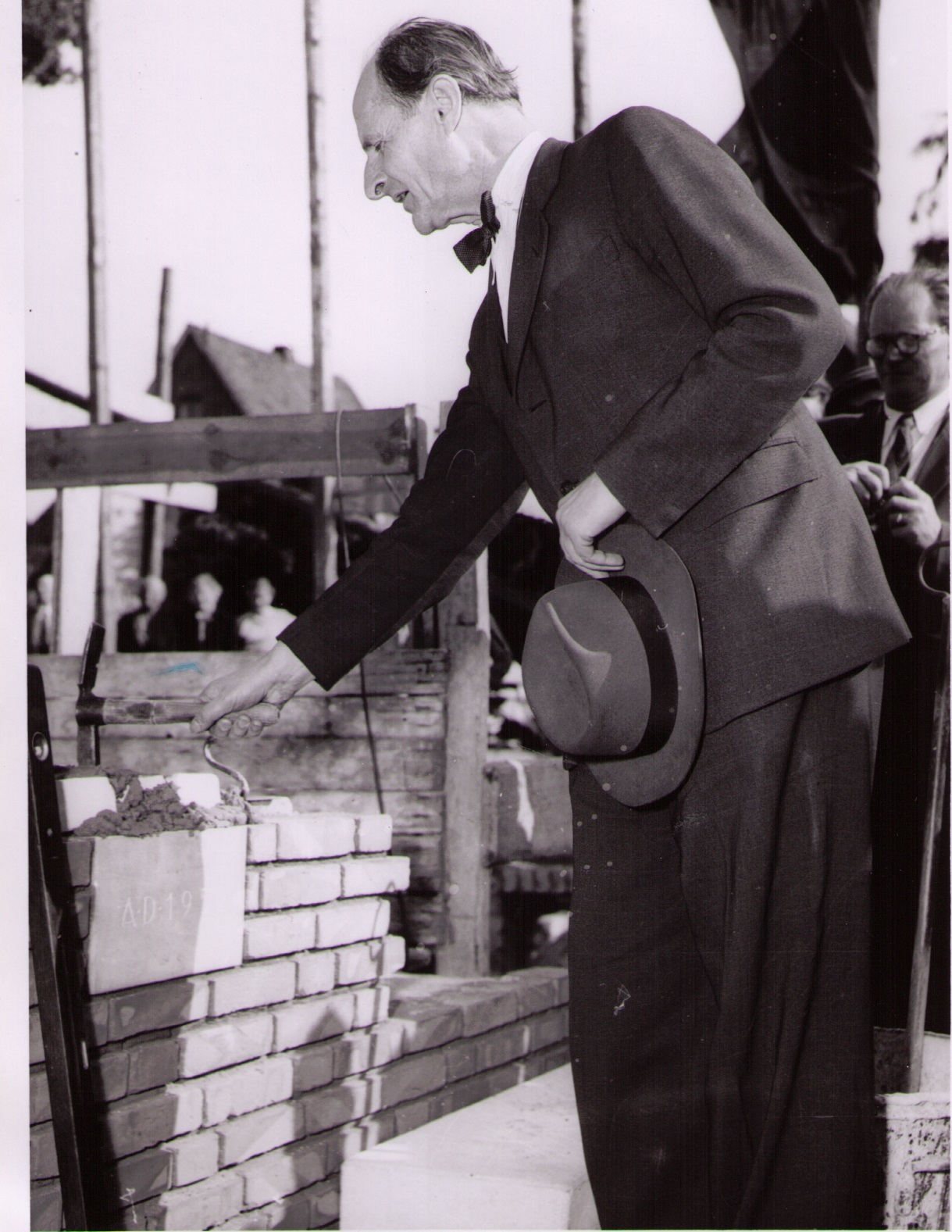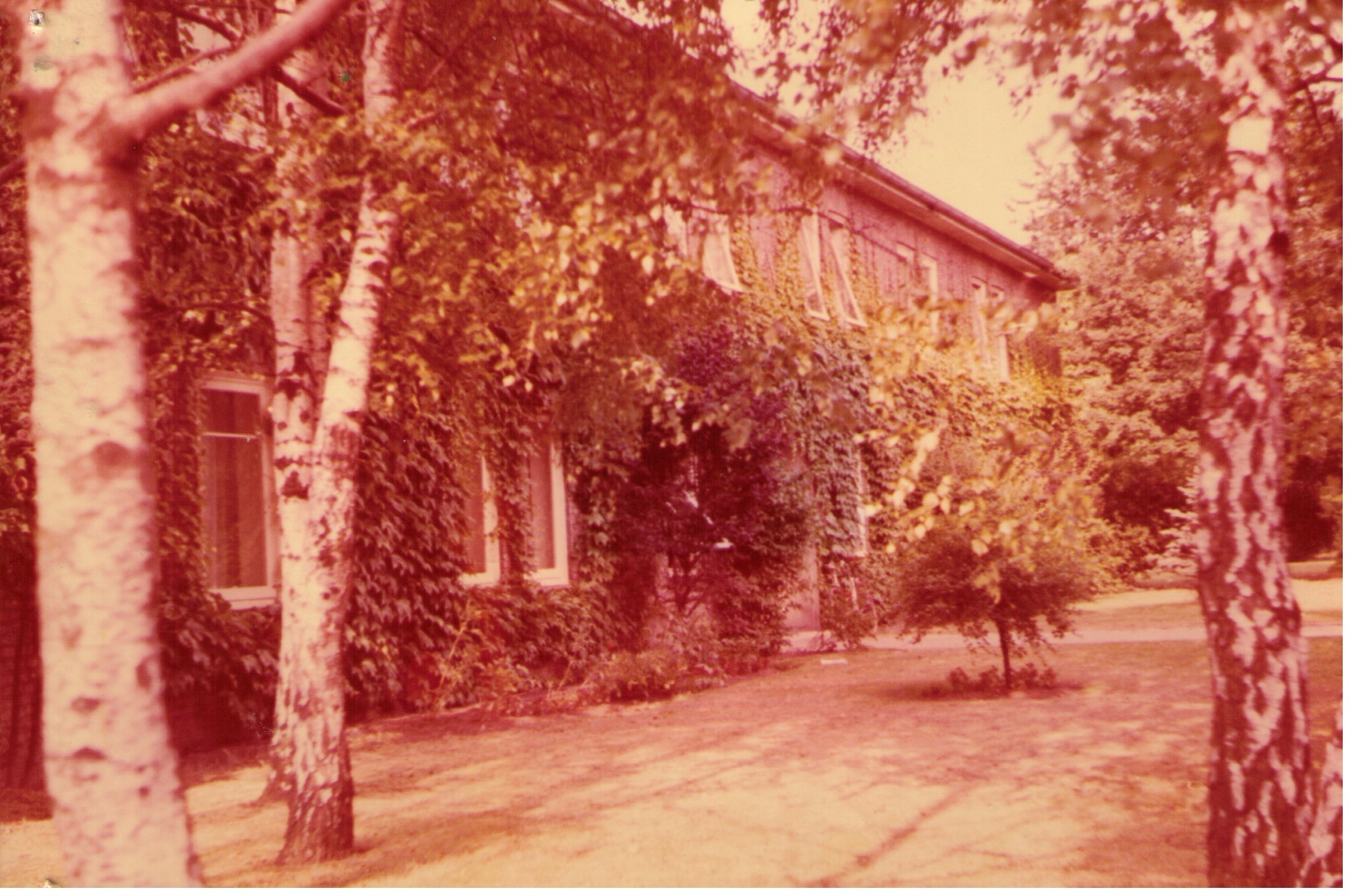The general housing shortage of the first years after the war had hit students particularly hard. After the Second World War a mere 20 emergency beds were offered in the decrepit provisional arrangement at 20 Tesdorpfstraße, which was but a shack on Sternschanze that served as a dormitory for 23 students. In the early 50s the first mayor of the Hanseatic City, Max Brauer, had supported an appeal to the Hamburg populace and merchants to build a new dormitory. According to the Hanseatic tradition, it was important “to give a place to spiritual and cultural concerns within the framework of its economic fabric.” The Acade-mix of Hamburg was indebted because of the Hanseatic merchants’ spirit of an “incorruptible sense of reality and the view of the widely tensioned horizon of the world”. “Out of thin air Christophorus-Haus was produced upon Hanseatic soil, (the interdependency between business and science).” And so Christophorus-Haus was founded in 1952 by prominent citizens, politicians, and religious persons to be in private ownership in Groß Flottbek. On 19 June 1952 the groundbreaking ceremony was held by Professor Bruno Snell and on 10 April 1953 the building on 74 Kalckreuthweg was inaugurated in the presence of the first acting Mayor, Max Brauer, and the Federal President, Theodor Heuß. It was the first dormitory in Hamburg after the Second World War and initially only had 100 rooms, that were available for use.
 “It is no coincidence that the construction of Christophorus-Haus, in which students themselves and the spiritual wealth of the Earth, should be daringly found in Hamburg, the city lead to be nicknamed ‘The Gateway to the World’. (…) The lavishness and generosity of the regal merchant, who is still today not yet extinct, even in our ill-disputed time, the sense of sacrifice, the willingness to help and ceaseless considerations that the individuals allow to arise in the making of this rich and exquisite facility.”
“It is no coincidence that the construction of Christophorus-Haus, in which students themselves and the spiritual wealth of the Earth, should be daringly found in Hamburg, the city lead to be nicknamed ‘The Gateway to the World’. (…) The lavishness and generosity of the regal merchant, who is still today not yet extinct, even in our ill-disputed time, the sense of sacrifice, the willingness to help and ceaseless considerations that the individuals allow to arise in the making of this rich and exquisite facility.”
Female students, at the beginning of the 50s, were still clearly a minority. Christophorus-Haus planned 42 rooms for the male students of the university, 22 rooms for the male students of the technical college, only 13 rooms for the female students of the university and 7 rooms for the female students of the technical college. The spatial separation of the sexes mirrored the zeitgeist.
The purpose of the house, especially with international students in mind, was open from the beginning, placing value upon the internationality of the residents.
“How society meets in this space of nationalities, the faculties treading on the same ground together, coming into contact and intellectual exchange; not only in natural sciences, social sciences, fine arts, and architecture, but also crafts, art, music… Which had promoted the aspiring “general studies”: a broad-based formation of future professional specialists.”
80 to 100 single rooms had been planned, for which the city of Hamburg provided 4080 sqm. of land for a building lease. The current main hall served as a dining and events room, small music practice rooms had also been popular from the very start. Many individual Hamburger donors, together with several companies, raised 80,000 DM, the McCloy Fund supported the project with 150,000 DM, and from the Main Office of Emergency Aid, a total of 160,000 DM had been granted. The interiors of the 6 sqm. rooms were calculated at a cost of 750 DM per room, which again would be financed by donations.
1954 The college of Europe purchased the identical building of house number 80 until they could purchase a new building on Windmühlenweg, and the Club of Christophorus-Haus registered association was able to over take the building. The College of Europe was founded in 1953 and is, just as Christophorus-Haus, still today organized as a private foundation. The College of Europe promotes research and academic teaching in the scope of European integration and international cooperation.
Dormitories should be more than just student accommodation. Through the so-called Hamburg “Protectors Order” of 1962, cultural life should be developed by way of close cooperation between instructors and students. In each dormitory a professor (some with family) moved in, who stood as “Protector” and as an available contact for residents. Thereby, Christophorus-Haus was itself an academic college. At the suggestion of the Protector, a “tutor” was appointed to provide political, musical, and other “mentally stimulating” events and who should “promote the forming of a lively household”. The task of the tutor in Christophorus-Haus was later replaced by a self-administration, which was carried out through a so-called house statute. They organized self dependent activities for the residents and could be influenced from the students’ view on future investments and renovations through a responsible member of the administration.
The student movement of 1968 shaped the self-perception of students of the 70s. It was a time of politicizing issues in the dormitories. As the responsible member of the administration had wanted to raise the 1974 cost of rent by 20% for the small 6 sqm. rooms with shared showers and furnishings, dating back to the foundation of the house, the residents stood in majority in the Rent-Strike and had paid monthly rent through escrow. Law students of the house represented the residents in the individual negotiations in court. The process ended with settlements, under which residents with older contracts were exempted from a supplementary claim. More recent agreements, however, were designed so that the rent legally could not be challenged. The strike had greatly strengthened a sense of community between the at that time residents, but was a test of endurance for the responsible member of the administration.
Just three years earlier, several dormitories in Hamburg had entered into a six-month Rent-Strike, which resulted in three private bearers not having been able to withstand the ordeal, and had transferred from the self-founded residencies to a student union.
The r esponsible member of the association of Christophorus-Haus had managed in the following decades, thanks to the commitment of Hamburg citizens, to be able to continue to fulfill the foundation’s purpose. Extensive interior renovations were promoted.
esponsible member of the association of Christophorus-Haus had managed in the following decades, thanks to the commitment of Hamburg citizens, to be able to continue to fulfill the foundation’s purpose. Extensive interior renovations were promoted.
Following the emancipation movement of the late seventies, a women’s group formed in Christophorus-Haus, which implemented an equal-gender team spokesperson for the home. In 1965, the Protector’s apartment was rededicated for the housing of students, who were to live in a “shared-living-space” and to share a common kitchen as well as bathroom between themselves. During a plenary meeting, representatives were chosen from among the residents, who, under the agreement with the house’s administration, protector, and board members, not only organized the direct shared-living of the residents, but also initiated and implemented a voluntary work-team, sports activities, a library organization, and an expansion of necessary digital communications frameworks.
After five years of struggle to find funding, the house was able to be completely renovated from 1985 until 1987. In addition, the procurator’s house was constructed behind house no. 74. For two years, the students lived in a construction site and had to move from one section to the next. The endeavor was worth it. The chairman, Pastor Heidenreich, thanked the senate for the generous subsidy, without which, the house would have been forced to close. For the 35-years of existence ceremony on 5 November 1987, the renovation was completed with a reception including the attendance of the University President, Dr. Fischer-Appelt. 27 rooms were economized, so that the remaining 149 rooms be bigger and more comfortable. New washing machines, refrigerators, as well as new music practice rooms for students of music in the basement floor finished off the arrangements.
1997 began the Digital Age in Christophorus-Haus, every room equipped with telephone and internet access. Through continual modifications, the residence life has been upgraded to meet the needs of the students. Smaller units based on the “apartment concept” of todays student common-living housing were used in place of long hallways with rows of single and double rooms.
2003 celebrated the fiftieth anniversary of Christophorus-Haus with the attendance of Senator Dräger, the University President, Dr. Professor Lüthje, along with residents and alumni of the house. The student union of Hamburg advised private dormitory board members to subsidize the renovations with public funds. The location of the former library on the main floor of the house had been moved to the basement floor of house no. 80 in 1975 to give way to the installation of additional dorm rooms. In 2007 the library was completely redesigned and refurnished, sponsored by the Rotary Club of Hamburg. In 2009 the dormitory installed a new high-speed fiber-optic internet connection with speeds up to 12MB/s. Years of extensive renovation complete with the enlarging of rooms, renovation of bathrooms and kitchens was largely completed in 2015. The house is declared to be a historic monument.
Currently, Christophorus-Haus has 147 residents, with a foreign population of 35%. Most of the 6 sqm. rooms were merged into 12 sqm. rooms and refurnished, kitchens and bathrooms mostly renovated, there is, as well, a gym, and a group workplace is being planned. Since it’s founding in 1953, once per semester, as a highlight of the house, a House Concert is put on, in which music students and amateur musicians are able to show off their skills.

